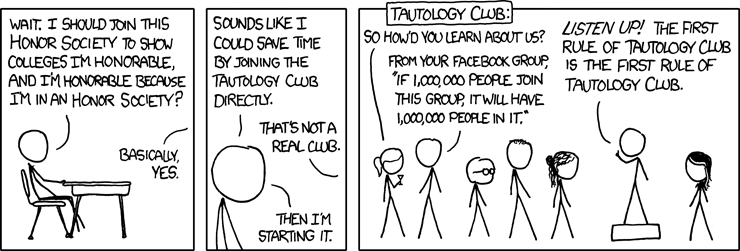We've now learned about propositions and how to use a truth table to determine the conditions under which a proposition is true or false. In this lesson we want to consider the question: What does it mean when two different-looking propositions end up having the same truth tables? Such propositions would be logically the same although they are superficially different. We will call those kinds of propositions equivalent. Also in this lesson we take up again the idea of the conditional statement and
Basic objectives: Each student is responsible for gaining proficiency with each of these tasks prior to engaging in class discussions, through the use of the learning resources (below) and through the working of exercises (also below).
- Explain what it means to say that two propositions are logically equivalent.
- Use truth tables to determine whether two propositions generated by 2--3 basic propositions are logically equivalent.
- Use truth tables to determine whether a proposition generated by 2--3 basic propositions a tautology or a contradiction or neither.
Advanced objectives: The following objectives are the subject of class discussion and further work; they should be mastered by each student during and following class discussions.
- Use truth tables to determine whether two propositions generated by 4 or more basic propositions are logically equivalent.
- Use truth tables to determine whether a proposition generated by 4 or more basic propositions a tautology or a contradiction or neither
To gain proficiency in the learning objectives, use the following resources. You may include other resources if you wish, in addition to or in replacement of the following.
Textbook: In Applied Discrete Structures, read Section 3.3. Make sure to read actively, working through examples and activities as you go.
Video: Watch the following videos at the MTH 210 YouTube playlist (http://bit.ly/GVSUCalculus).
- Tautologies and contradictions, part 1 (6:43)
- Tautologies and contradictions, part 2 (4:16)
-
Logical equivalence (8:02) -- Note that for logical equivalence your book uses the notation
$\Leftrightarrow$ instead of$\equiv$ . We will use the left/right arrow notation as well.
Comic: Enjoy the following xkcd comic.
The following exercises are to be done during and following your reading and viewing of the resources. Work these out on paper and then enter the responses into the appropriate submission form (see Submission Instructions) by the deadline. You will receive a mark of Pass if each item response shows a good-faith effort to be right and is submitted prior to the deadline.
- Here are four propositions. Determine which ones are logically equivalent.
- Consider the proposition
$(p \vee \neg p)$ . Use a truth table to determine whether this proposition is a tautology, a contradiction, or neither. Then explain why your answer makes sense from a common-sense perspective without any reference to a truth table. - Consider the proposition:
$(p \rightarrow q) \wedge (p \wedge \neg q)$ . Use a truth table to determine whether this proposition is a tautology, a contradiction, or neither. Then explain why your answer makes sense from a common-sense perspective without any reference to a truth table.
Submit your responses using the form at this link: http://bit.ly/1O5Grj0
